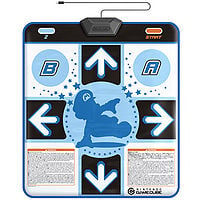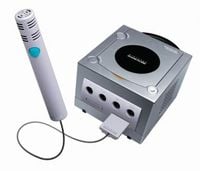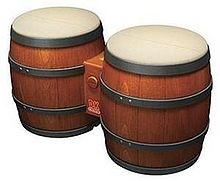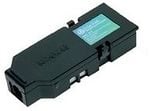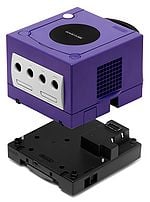Nintendo GameCube
Template:Articleabout Template:System-Infobox Template:LLQuote
The Nintendo GameCube is a home console system developed by Nintendo, and released late in the year of 2001 as the successor of the Nintendo 64. The console's preproduction codename name was "Project Dolphin" and was originally a console that used cartridges, as noted references appear in games such as Super Mario Sunshine. The Nintendo GameCube has six ports on its front: four controller ports and two memory card ports. It has three buttons on top: Open, Reset, and Power. On the bottom are two serial ports and one hi-speed port for add-on expansions. The system uses game discs based on a MiniDVD that are the size of an MP3 disc, able to hold up to 1.35 GB (1,459,978,240 bytes), making it the first Nintendo console to use optical discs as the primary storage medium. The Nintendo GameCube was officially discontinued in 2009 due to the leaving of Hiroshi Yamauchi. It sold about 22 million units during its lifetime.
The Nintendo GameCube was released in four colors: Indigo, Black, Orange, and Silver. Indigo is the original color seen in advertisements, the trophy in Super Smash Bros. Melee, and other places. Silver was released after the first three colors. Orange was not available in the United States, but controllers matching its color were.
The original version of the Wii, the successor of the Nintendo GameCube, is mostly compatible with Nintendo GameCube hardware and software. Like the Nintendo GameCube the Wii has 4 controller ports and 2 memory card slots which support all controllers, like the dance mat and microphone, though it does not support add-ons that attach to the console. Later revisions of the Wii, such as the Wii Family Edition and Wii Mini, would remove Nintendo GameCube support. The Wii U is also not compatible with any Nintendo GameCube games, but Super Smash Bros. for Wii U is compatible with the controllers through a special adapter.
Accessories and peripherals
Nintendo GameCube Controller
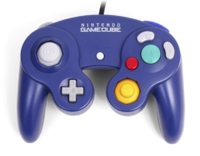
The Nintendo GameCube Controller is the system's standard controller. In addition to the standard buttons seen on the SNES and the control stick, introduced with the Nintendo 64, the Nintendo GameCube is also the first Nintendo system to feature a second analog stick, on the bottom right side of the controller. The controller also features two analog triggers on both sides of its back and a single shoulder button. The controller also features built-in rumble motor, carried over from the Nintendo 64's Rumble Pak add-on.
If the player holds ![]() during the startup of the console, the cube itself and the tiles will rotate, and the player gains rapid access to the main menu even if there is a disc in the console. Holding down
during the startup of the console, the cube itself and the tiles will rotate, and the player gains rapid access to the main menu even if there is a disc in the console. Holding down ![]() on one controller causes a xylophone to play, followed by a "BOING" and the laughter of a child. Holding down
on one controller causes a xylophone to play, followed by a "BOING" and the laughter of a child. Holding down ![]() on all four controllers causes a kabuki shout to play, followed by woodblocks, and then a whoop, followed by a triangle's "ding".
on all four controllers causes a kabuki shout to play, followed by woodblocks, and then a whoop, followed by a triangle's "ding".
A wireless variant of the Nintendo GameCube controller known as the WaveBird Wireless Controller is also available. It connects to the system via a radio sensor that plugs into one of the system's controller ports. However, the WaveBird does not support the rumble feature that the standard controllers have.
The Nintendo GameCube controller can also be used to play several Wii titles, including Mario Kart Wii and Super Smash Bros. Brawl as well as most Virtual Console titles. In addition, through use of the GameCube Controller Adapter for Wii U, the controller can be used to play Super Smash Bros. for Wii U. The accessory was released alongside an official Super Smash Bros.-themed GameCube controller.
Nintendo GameCube Action Pad
The Nintendo GameCube Action Pad is a dance pad controller released by Konami and packaged with Dance Dance Revolution: Mario Mix, the only game it is compatible with on the system. The pad only features eight buttons: the directional inputs, the A and B buttons next to the up button, and the Z and Start buttons on the top corners of the pad. Two versions of the pad were released.
Nintendo GameCube Microphone
The Nintendo GameCube Microphone is a special accessory used for Nintendo GameCube games on the GameCube or a backwards-compatible Wii. It is unusual in that it is plugged into a Memory Card slot rather than a controller slot. It has been used in Mario Party 6 and Mario Party 7 as a tool for playing mic minigames and making Mic Spaces functional. As the mic was intended to be used specifically with the GameCube, it is not compatible with any Wii games.
DK Bongos
The DK Bongos are bongo-like controllers for the Nintendo GameCube, primarily for use with the Donkey Kong series. Each side of the controller is shaped like a classic Donkey Kong barrel with a rubber drum skin fastened on top. It also has a built-in microphone to detect clapping (although hitting the sides of it also functions well). The DK Bongos detect left and right hits, and clapping. The DK Bongos were primarily used for the Donkey Konga series, though they are also the recommended controller for Donkey Kong Jungle Beat, and had Donkey Kong Barrel Blast been released for the Nintendo GameCube it would have also used the DK Bongos.
In Japan, the controller is called the TaruKonga (or "TaruConga") controller. The name is a multilayered pun, combining "Taru" (the Japanese word for "barrel"), "Kon", or "Con" (a suffix used by Namco when naming their original peripherals, such as the "GunCon", or the "TaTaCon"), and Konga (or Conga).
The DK Bongos are also compatible with the Wii.[1]
Nintendo GameCube Broadband Adapter
- Main article: Nintendo GameCube Broadband Adapter
The Nintendo GameCube Broadband Adapter is an add-on that allows players to connect their consoles via a local area network for system-to-system multiplayer. The device connects to the Nintendo GameCube by plugging into the bottom of the system. Only a few games are compatible with the adapter, including Mario Kart: Double Dash!!.
Game Boy Player
- Main article: Game Boy Player
The Game Boy Player is an add-on peripheral released in 2003 and allowing players to play Game Boy, Game Boy Color, and Game Boy Advance titles on their television screen through their Nintendo GameCube. The peripheral attaches to the bottom of the system, and requires a special disc in order to play any handheld titles. It is also capable of linking up to Game Boy systems and accessories, including the e-Reader and Game Boy Camera, and players can connect their Game Boy Advance systems to the Nintendo GameCube by use of the Nintendo GameCube - Game Boy Advance Cable to use their systems as a controller, though some games support the rumble feature included with the standard controller. During gameplay, players can bring up a menu with the ![]() button that allows them to scroll through various options, including setting the screen size, changing the border surrounding the game, changing the button mapping for a Nintendo GameCube controller, changing the screen filter, and setting a timer. Players can also select to change the cartridge from this menu without turning off the system.
button that allows them to scroll through various options, including setting the screen size, changing the border surrounding the game, changing the button mapping for a Nintendo GameCube controller, changing the screen filter, and setting a timer. Players can also select to change the cartridge from this menu without turning off the system.
Appearances in Mario games
Super Smash Bros. Melee
The Nintendo GameCube is a trophy in Super Smash Bros. Melee. It also appears as the only platform for Luigi's Target Test.
Mario Party series
Though a Nintendo GameCube doesn't actually appear in Mario Party 4, the Party Cube is a reference to the GameCube, and the rumble machine in the options screen is clearly based on the system. Additionally, a Nintendo GameCube can be seen inside the shops of Mario Party 6 and Mario Party 7.
Wario World
One of Wario's Treasures in Wario World is a Nintendo GameCube, found in a pink chest in Pecan Sands.
Mario Kart: Double Dash!!
The Nintendo GameCube battle course in Mario Kart: Double Dash!! is just a GameCube. This Nintendo GameCube logo can also appear at the bottom of the word "Mario Kart" on the five pointed star in Mario Circuit and Sherbet Land. The logo can also be seen on the billboards at Mushroom City.
Paper Mario series
In Paper Mario: The Thousand-Year Door, Lucky, the brown Bulky Bob-omb that runs the lottery in the west side of Rogueport, will mention the system's internal clock if the player attempts to cheat the lottery by changing the time.
In Super Paper Mario, Francis owns a GameCube which he keeps in his room with several other game systems.
Super Mario 64 DS
In Super Mario 64 DS, the Nintendo GameCube logo appears in the botton screen minimap of the castle courtyard (the back area with the Boos, not the front garden).
WarioWare: Touched!
In WarioWare: Touched!, one of the falling objects during the credit reel is a Nintendo GameCube logo. In the microgame Game On, a Nintendo GameCube, its controller cable and a game disc can be seen.
Hardware specifications
- MPU ("Microprocessor Unit")*: Custom IBM Power PC "Gekko"
- Manufacturing process: 0.18 micron IBM copper wire technology
- Clock frequency: 485 MHz
- CPU capacity: 1125 Dmips (Dhrystone 2.1)
- Internal data precision : 32-bit Integer & 64-bit floating-point
- External bus: 1.3GB/second peak bandwidth (32-bit address space, 64-bit data bus 162 MHz clock)
- Internal cache L1: instruction 32KB, data 32KB (8 way) L2: 256KB (2 way)
- System LSI: Custom ATI/Nintendo "Flipper"
- Embedded frame buffer: Approx. 2MB sustainable latency : 6.2ns (1T-SRAM)
- Embedded texture cache: Approx. 1MB sustainable latency : 6.2ns (1T-SRAM)
- Texture read bandwidth: 10.4GB/second (Peak)
- Main memory bandwidth: 2.6GB/second (Peak)
- Pixel depth: 24-bit color, 24-bit Z buffer
- Image processing functions: Fog, subpixel anti-aliasing, 8 hardware lights, alpha blending, virtual texture design, multi-texturing, bump mapping, environment mapping, MIP mapping, bilinear filtering, trilinear filtering, anisotropic filtering, real-time hardware texture decompression (S3TC), real-time decompression of display list, HW 3-line deflickering filter.
Trophy information from Super Smash Bros. Melee
| Type | Image | Description | |
|---|---|---|---|
| Nintendo GameCube | File:Trophy290.PNG | Nintendo GameCube Hardware |
Nintendo's latest bundle of joy arrived in North America on November 18, 2001, and video-game fans rejoiced. This little beauty is sleek, compact and full of cutting-edge technology. Incorporating optical media for the first time, the Nintendo GameCube was truly born to play. Rumor has it that Super Smash Bros. Melee is a software title for this wondrous device. |
Game gallery
- ToadstoolTour.PNG
- Mpp4.JPG
- MP5BOX.PNG
- MP7BOX.PNG
- NPC.jpg
- SuperMarioStrikers.JPG
- Box NA - Super Mario Sunshine.png
- Super Smash Bros Melee Players Ch.jpg
Super Paper Mario and Donkey Kong Barrel Blast (while under the working title of DK Bongo Blast) were originally going to be released for the Nintendo GameCube; they were moved to the Wii due to the Nintendo GameCube reaching the end of its lifespan.
Trivia
- The GameCube menu music is actually a slowed-down version of the Famicom Disk System startup tone.
- The DK Bongos are featured in Super Smash Bros. Brawl and Super Smash Bros. for Nintendo 3DS / Wii U as Donkey Kong's Final Smash, Konga Beat.
- The directional pad on the Nintendo GameCube Controller had the same size and shape as the original Game Boy Advance.
- The GameCube is often abbreviated as "GCN", although in reality this would be an incorrect abbreviation as it would stand for "GameCube Nintendo". A correct abbreviation would be "NGC", which is also the Japanese version of the abbreviation.[2]
- The GameCube is currently the latest home console to receive an entry of the Mario Golf series. It was the latest console to receive a game in the series, up until the 2014 release of Mario Golf: World Tour for the Nintendo 3DS.
References
- ^ Wikipedia (Accessed on 5-16-08)
- ^ Bulbapedia

